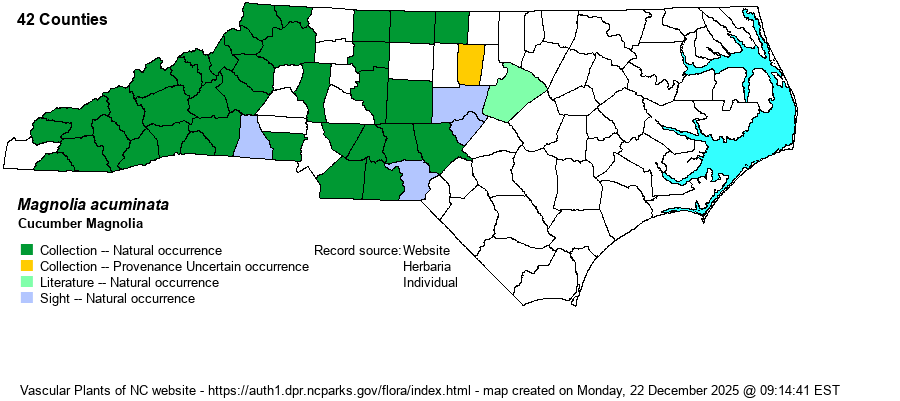| Author | (L.) L. | |
| Distribution | Throughout the Mountains, and present over most of western and central Piedmont, east to Caswell, Wake, and Moore counties. (There is a small disjunct population along Kit Creek in western Wake and eastern Chatham counties.) Absent from the northeastern portion of the Piedmont, and all of the Coastal Plain. Ranges in the southeastern Piedmont to the edge of the Fall Line, along the Pee Dee River and tributaries of the Deep River.
This is primarily a species of the Appalachian Mountains and Piedmont, though it does extend southward into the Gulf Coastal Plain. The range extends from MA (introduced), Ont., and southeastern MO, south to northwestern FL and LA. It is scarce in Midwestern states west of OH, and essentially absent from the Atlantic Coastal Plain.
| |
| Abundance | Fairly common to locally common in the Mountains; fairly common in the western Piedmont and foothills; uncommon to locally fairly common in the rest of the Piedmont range. In most of its NC range, it is outnumbered by other magnolia species, such as M. fraseri in the Mountains, and M. tripetala in much of the central Piedmont. | |
| Habitat | This species favors mesic, and somewhat rich, forests, typically on slopes over circumneutral soils, but in the Mountains it can occur in more mesic and less high pH soils. However, it is not a major component of Rich Cove Forests, preferring somewhat drier slopes in the mountains. In the eastern Piedmont, however, it usually is restricted to rich forested soils over mafic rocks (high pH soil). The two Moore County collections were from mesic hardwoods on rocky creek banks in the Slate Belt. | |
| Phenology | Blooms from April to June; fruits from July to August. | |
| Identification | This is a rather familiar deciduous tree that grows mainly to medium height, averaging about 70 feet tall; in the Piedmont it is normally much smaller. It usually can be identified by having among the largest truly elliptical leaves of any tree in the state (with no basal lobes, etc.); the leaves are alternate, entire, and average 6 inches long and 4 inches wide. The petioles are quite long, often approaching an inch. The large (but small for a magnolia) flowers have erect to ascending petals that are 2-3 inches long, pale greenish-yellow below and variously bright yellow or greenish-yellow above. They are not nearly as conspicuous as the flowers of the other magnolias in the state. In the cooler months, the species can be identified by the naked end buds that are pale gray and look like a Q-tip. Despite these field marks, it can be overlooked by many people, even in the growing season, as it is seldom truly common in most areas. And, many of the photos submitted to iNaturalist claiming this species are incorrect; the average outdoor enthusiast cannot safely identify the species. | |
| Taxonomic Comments | Weakley (2018) and a few other references list varieties for the species. In the state, the nominate variety – M. acuminata var. acuminata – is the only one in the Mountains and upper Piedmont, whereas M. acuminata var. subcordata is the primary or only form in the mid and lower Piedmont. This latter one occurs mainly on high pH soil, is a small tree, and has brighter golden-yellow petals.
| |
| Other Common Name(s) | Cucumber-tree, Mountain Magnolia. Cucumber-tree is often in more frequent usage than is Cucumber Magnolia, but that is an idiosyncratic name that implies or suggests no close relatives and does not hint at its taxonomy. Most other magnolias use “Magnolia” in the common name; thus, Cucumber Magnolia is the more appropriate name. | |
| State Rank | S5 | |
| Global Rank | G5 | |
| State Status | | |
| US Status | | |
| USACE-agcp | FACU link |
| USACE-emp | FACU link |

